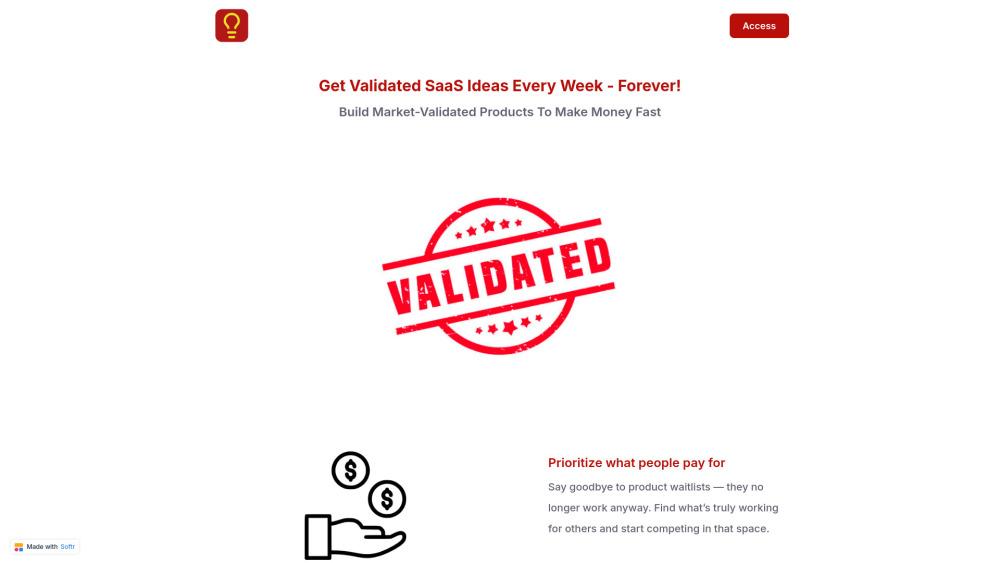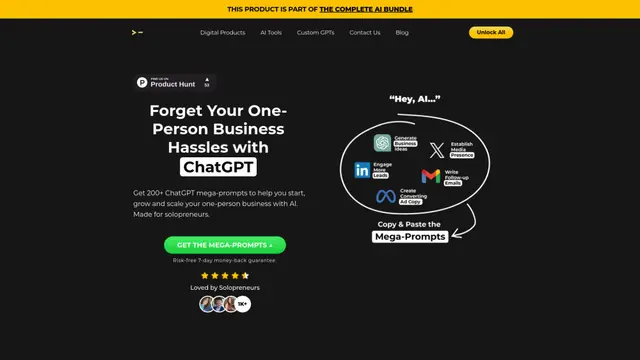Micro SaaS Ideas
Micro SaaS Ideas are small-scale, niche-focused software solutions that target specific problems or markets, offering entrepreneurs a way to build profitable businesses with minimal resources and complexity.
https://validatedsaas.com/

Product Information
Updated:Jul 16, 2025
Micro SaaS Ideas Monthly Traffic Trends
Micro SaaS Ideas received 27.0 visits last month, demonstrating a Slight Decline of -12.9%. Based on our analysis, this trend aligns with typical market dynamics in the AI tools sector.
View history trafficWhat is Micro SaaS Ideas
Micro SaaS Ideas represent a growing segment in the software-as-a-service industry that focuses on creating targeted solutions for specific market needs or user pain points. Unlike traditional SaaS businesses that aim for broad market appeal, micro SaaS ventures are intentionally smaller in scope, typically managed by solopreneurs or small teams, and designed to serve particular niches effectively. With Gartner predicting cloud consumers will invest $232 Billion in SaaS solutions in 2024, the micro SaaS model has emerged as an attractive option for entrepreneurs looking to enter the market without massive capital investment or extensive development resources.
Key Features of Micro SaaS Ideas
Micro SaaS Ideas are small-scale, niche-focused software solutions that target specific problems or needs within various industries. These solutions are typically built and managed by small teams or solo entrepreneurs, requiring minimal initial investment while offering potential for steady revenue growth. The concept emphasizes building focused features that solve real problems, validating ideas through market research and user feedback, and utilizing no-code/low-code tools for rapid development and deployment.
Market Validation Tools: Provides access to validated business ideas through market research, competitor analysis, and real user feedback to ensure product viability before development
Niche-Specific Solutions: Focuses on addressing specific pain points within targeted industries rather than trying to be a one-size-fits-all solution
Rapid MVP Development: Enables quick development of minimum viable products using no-code/low-code platforms, typically within 4-8 weeks
Scalable Architecture: Allows for gradual growth and feature expansion while maintaining a lean operational structure
Use Cases of Micro SaaS Ideas
Marketing Analytics Tools: Social media management and analytics tools for small businesses to track performance metrics and audience engagement
HR Management Solutions: Employee engagement and management tools for remote teams, including performance tracking and communication features
E-commerce Optimization: Specialized tools for online retailers to manage inventory, analyze sales data, and automate customer service
Creative Professional Tools: Specialized software for artists and creators to manage sales, track orders, and showcase their work
Pros
Low initial investment and operational costs
Quick time to market with MVP approach
Highly focused solution for specific target markets
Easier to maintain and scale gradually
Cons
Limited market size due to niche focus
Strong competition in popular niches
May require continuous feature updates to remain competitive
How to Use Micro SaaS Ideas
Identify and Research Problem: Start by identifying a specific issue or pain point that affects small businesses. Research existing solutions in the market to understand the competitive landscape and find gaps you can fill with your micro-SaaS solution.
Validate Your Idea: Validate your micro-SaaS idea through multiple methods: Talk to potential users (asking specific questions about their problems rather than if they want your solution), join relevant online communities, conduct surveys, and analyze market demand. Look for evidence of 1000+ potential users.
Create Landing Page: Build a simple landing page that clearly explains your proposed solution and includes an email signup form. Drive traffic to test interest and collect emails of potential early users.
Build MVP: Develop a minimum viable product (MVP) with core essential features only. Focus on solving the main problem effectively rather than adding many features. The MVP should be simple enough to build in a short timeframe.
Get Beta Users: Release your MVP to a small group of beta users. Gather feedback on functionality and user experience. Use this feedback to validate that your solution effectively solves their problem.
Iterate Based on Feedback: Make improvements to your product based on beta user feedback. Focus on fixing critical issues and adding only the most requested essential features.
Launch and Market: Once validated with beta users, launch your product publicly. Focus marketing efforts on your specific niche through relevant channels where your target users are present.
Monitor and Scale: Track key metrics like user adoption, retention and revenue. Scale gradually by continuing to gather feedback and making incremental improvements while keeping the product focused and simple.
Micro SaaS Ideas FAQs
Rather than directly asking people if they need your solution, focus on understanding real user behavior and problems. Conduct proper market research, talk to potential users about their specific pain points, and validate unique value propositions. The most foolproof way is to test real world behavior through an MVP. For derivative solutions, focus on validating your unique value proposition compared to existing alternatives.
Official Posts
Loading...Analytics of Micro SaaS Ideas Website
Micro SaaS Ideas Traffic & Rankings
27
Monthly Visits
-
Global Rank
-
Category Rank
Traffic Trends: Apr 2025-Jun 2025
Micro SaaS Ideas User Insights
-
Avg. Visit Duration
1.01
Pages Per Visit
46.58%
User Bounce Rate
Top Regions of Micro SaaS Ideas
IN: 100%
Others: 0%











